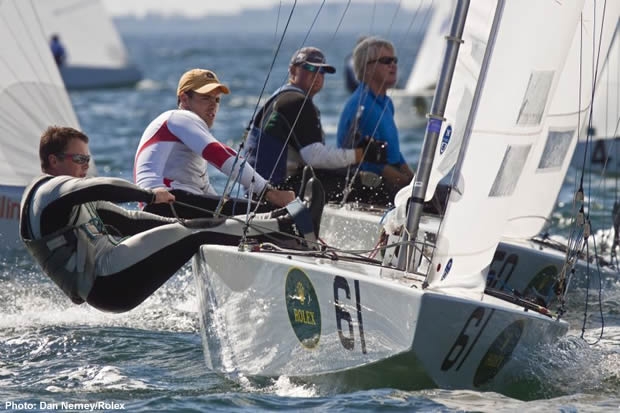
Star debate
With the prospect of the Star being cast of the Olympic sailing line-up come 2016, so we spoke to several leading exponents of the discipline to get their thoughts on the choice of equipment for Rio.
 Now head of Torbjorn Tornqvist’s Artemis Racing, Paul Cayard has used the Star to sharpen the skills that have caused him to win the Volvo Ocean Race and compete in numerous America’s Cups. A class regular for more decades now, Cayard finished third in his first Star Worlds in 1992, won the North Americans in 1994 and 2003, was second and third in the Bacardi Cups in 1996 and 2001 respectively, won the Western Hemisphere Championships in 2005 and 2009 and ended up fifth at the Athens Olympics.
Now head of Torbjorn Tornqvist’s Artemis Racing, Paul Cayard has used the Star to sharpen the skills that have caused him to win the Volvo Ocean Race and compete in numerous America’s Cups. A class regular for more decades now, Cayard finished third in his first Star Worlds in 1992, won the North Americans in 1994 and 2003, was second and third in the Bacardi Cups in 1996 and 2001 respectively, won the Western Hemisphere Championships in 2005 and 2009 and ended up fifth at the Athens Olympics.
Cayard repeats the Iain Percy argument that keelboat racing represents the majority of sailing. “In the Olympics there are 10 boats, 10 classes, the question is – why is that? My guess is to give a little bit of a cross section of the sport. Well, a large part of sailing has keelboats in it, so to think that not one 10th of the cards spent on Olympic classes is going to be spent on a keelboat - I think we are missing a little bit there.”
Given that keelboats represent the largest single boat genre in sailing Cayard goes on to ponder what if sailing at the Games were only allowed one class? To be representative of our sport, surely a keelboat would be best?
“There is a lot of history in the Star. Iain Percy, Robert Schiedt, Torben Grael, myself - at a certain point we all end up coming to the Star class and testing their mettle there. Why? Because it is a very challenging class and there is enough technical going on with the rig and all that and the fleet is very competitive and it is one design enough that everything is tight and there is some indescribable magic in that formula: it works.”
So if there is to be a keelboat in the Olympics then why not replace the Star with something more contemporary or cheap like a J/24? “There is something very cool about the Star," states Cayard. "It has low freeboard, a really big mainsail sealed to the deck. A J/24 looks like a conker. The Star looks sleek and the crew is over the side really low to the water. And it is just a slick machine, considering it is a 100 year old design.”
And the mixed 470? This doesn’t light the touch paper to quite the same degree as it did with Iain Percy. “The problem here is that the MNAs vote on what equipment is used and the 470 is popular in Asia so the Asian contingent lobbied to make sure that stayed in. Is that a good thing? I don’t know.”
 New Zealand-based Rod Davis has been to the Games twice in the Star, returning with silver from the Barcelona Olympiad in 1992 and a fifth place four years later in Savannah.
New Zealand-based Rod Davis has been to the Games twice in the Star, returning with silver from the Barcelona Olympiad in 1992 and a fifth place four years later in Savannah.
“The Olympics are a funny little case where the IOC keeps putting hoops up and ISAF has to jump through the hoops,” says Davis of the proposed changes in equipment for 2016. “It is difficult to know exactly what should happen there. Take the case of there being 50% women at the Olympics now. Well we don’t have 50% women sailing...” Dangerous territory, as we found out recently at the World Yacht Racing Forum. “10% -whatever – it is a small percentage. So where are we going to get 50% of women sailing? So that is a hoop that IOC strongly suggests and now we have got 48 Lasers, that is 48 countries. We don’t have 48 countries that sail Lasers. We have got to create countries. So we are getting away from what sailing is and turning it into something that the IOC wants. Is that good or bad and can you stop it? We all accept that sailing needs to be in the Olympics, but maybe we need to find a niche where sailing can keep its identity.
Maybe that is just being old fashioned. My Olympic days are done. ‘You just like the Star boat’. I do want sailing to stay in the Olympics, I just think sailing needs to keep its identity.”
The attraction of the Star, as Cayard points out, is that it is not just a keelboat, but a special one. It’s tweaky. “We do like the Star because it is tweaky,” admits Davis. “The funny thing about the Star and the great thing about it, is what you gain in experience in your years and you lose in your athletic ability, the lines are so close together and cross but they stay really close together. So you can be 23 and really good in your Star boat and racing really close to a guy who is 53 and he can’t physically go against you, but he has more tricks up his sleeve and you go around the course side by side all the way. You can sail a Star for 25-30 years and be competitive. You can’t do that in a Laser or any other boat.
“The Star – it has a special place in my heart because of my history, but it is real real expensive, the most expensive boat to campaign for the Olympic Games. And if we are looking to modernise, the Star isn’t modern.”
A bigger question is whether the Olympic Games is an event for ‘oldies’. Some cite the argument that the Games should be for the up-and-coming young blades. However equally the word from the IOC is that the events at the Games should reflect the sport and there is no question that one of the unique features of sailing is that it is a discipline where 50 year olds can still be competitive. If the Olympics is indeed one of the pinnacle events within sailing then surely it should provide the opportunity for the best sailors to take part, not just the best 20-30 year olds?
“I don’t know – do you want 50 year old in the Olympics?” questions Davis. “Maybe not. The only 50 years old you have in the Olympics at the moment are the shooters. But you don’t see them in the pool, etc.
“The Star boat has been thrown out of the Olympics before and made a comeback. The Tempest got in there for a little bit. The scary thing is - and the same is true with the America’s Cup - we are trying to get a younger, more tech savvy audience, but when we go and do that we do risk our normal clientele. Everyone who owns a J/24 can kind of relate to a Star, but he can’t relate to a 49er. Or he can relate to an America’s Cup monohull, but he can’t relative to a catamaran. When we go after this young clientele, what are we competing against? Video games, Tour of Duty 3, etc. These young guys – are they going to want to play an interactive video game or are they going to want to watch a sail boat race? I’m not sure we will ever get them or but in the process we might risk losing what we have. I am not saying it is a bad move, you just need to think it all the way through to the conclusion to find out where it ends up.”
 A relative newbie in comparison, having only been in professional sailing for just over a decade, is Kiwi AC sailor and Olympian, Hamish Pepper. As an Olympic sailor Pepper represented his country at the Olympics in the Laser in Savannah and Athens, before graduating up to the Star in 2006, coming home ninth at the Beijing Games. However he is a past Star World Champion, winning at the hotly contested regatta in San Francisco in 2006 and was second in 2009 in Varberg, Sweden.
A relative newbie in comparison, having only been in professional sailing for just over a decade, is Kiwi AC sailor and Olympian, Hamish Pepper. As an Olympic sailor Pepper represented his country at the Olympics in the Laser in Savannah and Athens, before graduating up to the Star in 2006, coming home ninth at the Beijing Games. However he is a past Star World Champion, winning at the hotly contested regatta in San Francisco in 2006 and was second in 2009 in Varberg, Sweden.
For this Olympic cycle Pepper has teamed up with Barcelona Finn bronze medallist turned America’s Cup grinder, Craig Monk.
“It is a shame because the new generation of sailors that are coming through, the Paul Goodisons and all those sorts of guys and Ben Ainslie – what are they going to sail after this Games?” says Pepper of the Star’s proposed departure. “It is naturally the boat of choice after the dinghies and it gives a lot of people - catamaran sailors, 49er sailors, Laser/Finns sailors - the chance to stay in Olympic sailing. So it is a shame because our life expectancy in the dinghies is until our low 30s and the Star gives you the opportunity to sail the Olympics for another 10 years. The legends of the class often are attracted to that type of boat and it is a fun, enjoyable physical boat.
“You are going to lose people like Paul Cayard and John Kostecki out of the Olympics because they are too old. I think it is important to have a boat that the legends can step in and sail if they choose to try and go to the Olympics and win a medal.
“To be honest this will probably be my last Olympics, because it’ll be number four for me and I have got a family now, but it is my choice rather than it being forced on me! I just think it is a shame. There are exciting classes out there, but it is also good to have smart sailors and the legends of the sport able to go to the Olympics.
“It is a tricky situation. I think if they spend the money on TV technology in terms of on board cameras. You can spice sailing up and you can make Star or Finn or Laser sailing look very good and you can still have your Moths and your skiffs and catamarans and your fast boats. I don’t think they have done a particularly good job in choosing the classes full stop.”









Latest Comments
Add a comment - Members log in